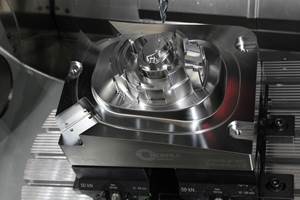Conquering the Complex Task of Tool Optimization
Standard coatings can help, but to achieve really impressive results all the factors must be coordinated with one another—from the base material of the tool to the post treatment of the coating.
Machining is a metalcutting process that has to fulfill increasingly high demands with regard to productivity and processing speed. The friction arising during the process and the wear on components and tools are major loss factors. According to the German Society for Tribology, a loss of about five percent of gross social product arises annually in industrialized countries through the effects of friction and wear alone.
Tool coatings (see Figure 1) counter these mechanisms and so are essential in machining. Providers of surface technologies have been developing tailor-made coating solutions for many years to make tools more resistant, more productive and longer lasting. The unique challenge is the consideration and streamlining of four influencing factors:
1. Pre- and post-treatment of the tool surface
2. Coating material
3. Layer architecture
4. System technology with which the coating will be applied
Origin of Wear
During the machining process, some wear mechanisms take place in the area the tools contact the material. For example, adhesion between chips and the cutting surface; abrasion through hard materials within the material; and, tribochemical reactions (chemical material behavior due to mechanical action and high temperatures). These tribological stresses largely characterize the efficiency of tools because they reduce the cutting forces and shorten service life.
A surface coating may reduce the impact of the tribological stresses, while the base material of the tool takes over the supporting function and absorbs the mechanical stresses. In addition to increased productivity, improvement in the tribological system also leads to savings in material and energy.
Impact of Coatings on Machining Cost Reduction
An important cost factor in the production cycle is the service life of the tools. Among other things, this is understood as the period during which a machine can work without interruption before it requires maintenance. The longer the service life, the lower the costs that arise due to production interruptions and the lower maintenance work will be.
The use of coatings increases the service lives of the tools—even at high process temperatures—and thereby, considerably reduces the costs. In addition, fewer lubricants are needed. This not only reduces the material costs, but also helps protect the environment.
Impact of Pre- and Post-Treatments on Productivity
In modern machining processes the cutting tool is subjected to high pressures (more than 2 GPa), high temperatures and thermal cycling stresses. The pre- and post-treatment—as well as the coating—must be adapted to the application.
There are various pretreatment methods available that prepare the tools for a subsequent coating process, significantly improving the coating adhesion at the same time. Together with the coating, a preparation of the cutting edge of the tool leads to increased cutting speeds, feed rates and longer service lives.
The post-treatment (edge preparation, surface treatment and structuring) also plays a decisive role. In particular, in avoiding initial wear that can occur through cutting edge buildup (adhesion of material from the workpiece to the cutting tool).
Coating Considerations and Options
The requirements that are placed on coatings can be very different. As high temperatures arise at the cutting edge during machining, high resistance to thermal wear becomes extremely important. The following properties are expected from modern coatings: excellent high-temperature properties, resistance to oxidation, high hardness (even at high working temperatures) and microductility (plasticity) through a nano-structured layer design.
In the case of high-performance tools, optimal adhesion of the coating and well adapted residual stress are decisive factors. Above all, this applies to the interaction between the base material and the applied coating. The coating material should have the least possible affinity to the material being worked on. In this way—with suitable cutting geometry and by smoothing or polishing of the coating—the adhesion tendency can be significantly reduced.
Aluminum-based coatings, such as AlTiN (titanium aluminum nitride), are often used in the machining industry. In these aluminum-based coatings, a thin but dense aluminum oxide layer forms as a result of the high temperatures during machining. This layer then continually and independently renews itself, and protects the coating and the base material below it from oxidative decay.
The required hardness and resistance to oxidation can be adjusted through a variation of the aluminum content and the layer morphology. For example, the resistance to oxidation can be improved through an increased aluminum content, nano-structuring or microalloying (i.e., alloying with low-percentage element proportions).
In addition to the chemical composition of the material, the layer architecture can also considerably alter the properties of a coating. Different tool properties arise depending on the distribution of the elements in the microstructure of a layer.
Today, several individual layers with different chemical compositions can be combined to achieve customized properties. This trend will increase even more in the future—particularly through new system and process technologies, such as the HI3 (High Ionization Triple) technology that is an arc and sputtering hybrid technology, combining three high ionization processes.
Titanium-silicon-based (TiSi) coatings provide outstanding results as all-rounders. These coatings can be used for very hard steels (up to 65 HRC Rockwell core hardness) with a variable proportion of carbide as well as for medium-hard steels (40 HRC Rockwell core hardness). The layer design is similarly adapted in order to meet the diverse range of application areas. As a result, the surfaces are equipped for the machining of everything from high- and low-alloy steels to hardened materials and titanium. In short- and long-term tests, TiSi-based coated copy mills showed service lives that were almost doubled due to reduced cutting edge wear and enhanced surface quality. Further tests carried out in the fine-finish machining operation (on flat workpieces with a Rockwell-hardness of 44 HRC) made it clear that a service life that is almost three times as long and a tenfold reduction in roughness can be achieved with coated tools.
The subsequent polishing of the surface could be minimized. Such coating families have potential in applications in which high cutting speeds, high temperatures at the cutting edge and high metal removal rates are required.
For additional PVD coatings (and in particular, for micro alloyed coatings), coating companies also carry out research on optimized surface solutions in close cooperation with machining companies. As a result, potential improvements in productivity, tool usage, quality, and the interplay between material, coating and application can be realized and utilized. Through expert coating partners, customers can increase the efficiency of machining tools throughout their complete life cycle.
Related Content
6 Ways to Optimize High-Feed Milling
High-feed milling can significantly outweigh potential reliability challenges. Consider these six strategies in order to make high-feed milling successful for your business.
Read MoreTen Things You Need to Know about Circle Segment Milling
Considerations for evaluating if circle segment end mills or conical barrel cutters are right for your mold machining applications.
Read MorePrecision Meets Innovation at IMTS 2024
After attending IMTS, it's clear that the integration of advanced technologies is ready to enhance precision, efficiency and automation in mold manufacturing processes. It’s a massive event, so here’s a glimpse of what the MMT team experienced firsthand.
Read MoreRead Next
Help Your Customers Reduce the Cost of Making Plastic Parts
How to take advantage of the properties of DLC coatings to design better molds and improve cycle times.
Read MoreHow to Use Continuing Education to Remain Competitive in Moldmaking
Continued training helps moldmakers make tooling decisions and properly use the latest cutting tool to efficiently machine high-quality molds.
Read MoreAre You a Moldmaker Considering 3D Printing? Consider the 3D Printing Workshop at NPE2024
Presentations will cover 3D printing for mold tooling, material innovation, product development, bridge production and full-scale, high-volume additive manufacturing.
Read More












.png;maxWidth=300;quality=90)













